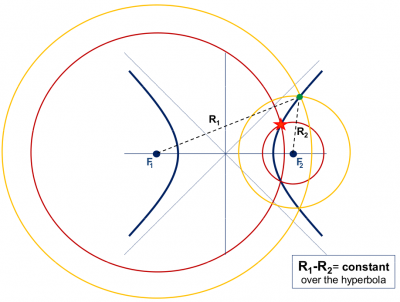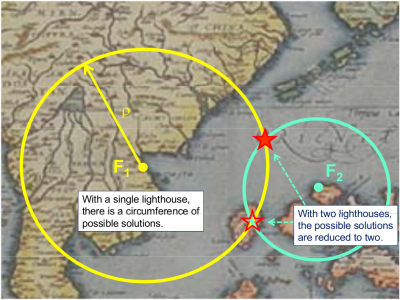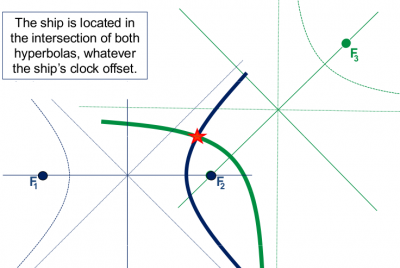If you wish to contribute or participate in the discussions about articles you are invited to contact the Editor
An intuitive approach to the GNSS positioning: Difference between revisions
| Line 30: | Line 30: | ||
[[File:Unknown Offset3.png|none|thumb|400px|'''''Figure 1.4:''''' Geometrical view 2-D positioning, complementing the figure 1.3.]] | [[File:Unknown Offset3.png|none|thumb|400px|'''''Figure 1.4:''''' Geometrical view 2-D positioning, complementing the figure 1.3.]] | ||
Finally, and in order to simplify the explanation, let's go back to the situation of figure 1.1 where the ship and lighthouses clocks are assumed fully synchronised. | |||
If the range measurements were perfect, the sailor could determine his position as the intersection point of the two circles centred at F1 and F2 lighthouses. | |||
However, the measurements are not exact, having some measurement error ". Figures 1.5 and 1.6 illustrate how this measurement error is translated to the | |||
coordinates estimate as an uncertainty region, which depends on the geometry defined by the ship and lighthouses relative positions. | |||
[[Category:Fundamentals]] | [[Category:Fundamentals]] | ||
Revision as of 23:48, 4 January 2011
The basic observable in a GNSS system is the time required for a signal to travel from the satellite (transmitter) to the receiver. This travelling time, multiplied by the speed of light, provides a measure of the apparent distance (pseudo range) between them. The following example summarises, for a two-dimensional case, the basic ideas involved in the GNSS positioning:
Let's suppose that a lighthouse is emitting acoustic signals at regular intervals of 10 minutes and intense enough to be heard some kilometres away. Let's also assume a ship with a clock perfectly synchronised with the one in the lighthouse, receiving these signals at a time not being an exact multiple of 10 minutes, for example, 20 seconds later [math]\displaystyle{ \left (t = n * 10^m + 20^s \right) }[/math] These 20 seconds will correspond to the propagation time of sound from the lighthouse (transmitter) to the ship (receiver). The distance ρ between them can be obtained multiplying this value by the speed of sound [math]\displaystyle{ v \simeq 335 m/s }[/math]. That is, ρ = 20 s * 335 m/s = 6.7 km. Obviously, with a single lighthouse it is only possible to determine a single measure of distance. So, the ship could be at any point over a circle of radius ρ, see figure 1.1.
With a second lighthouse, the ship position will be given by the intersection of the two circumferences centred in the two lighthouses and radius determined by their distances to the ship (measured using the acoustic signals). In this case, the ship could be situated at any of the two points of intersection shown in figure 1.1. A third lighthouse will solve the previous ambiguity, nevertheless a rough knowledge of the ship position may allow us to proceed without the third lighthouse. For instance, in figure 1.1, one of the solutions falls on the ground (on an island).
A deeper analysis of a 2-D pseudorange based positioning
Right now, a perfect synchronism between lighthouses and ship clocks has been assumed, but in fact this is very difficult to assure. Notice that a synchronism error between these clocks will produce an erroneous measure of signal propagation time (because it is linked to such clocks) and, in consequence, an error in the range measurements. Let's assume that the ship clock is biased by an offset [math]\displaystyle{ d \tau }[/math] regarding the lighthouses clocks (which are supposed to be fully synchronised). Thence, the measured ranges, [math]\displaystyle{ R_1\, and\, R_2 }[/math], will be shifted by an amount [math]\displaystyle{ dt\, =\, v.d \tau }[/math]:
[math]\displaystyle{ R_1 = \rho_1 + dt,\, R_2 = \rho_2 + dt \qquad \mbox{(1.1)} }[/math]
That is, the radius of the circles of figure 1.1 will vary by an unknown amount [math]\displaystyle{ d t }[/math], see figure 1.2. From hereafter we will call [math]\displaystyle{ R_i }[/math] as pseudorange, because it contains an unknown error [math]\displaystyle{ d t }[/math]. At first glance, it might seem that the intersection of these circles (with an undefined radius [math]\displaystyle{ R_i }[/math]) could reach any point on the plane (for an arbitrary [math]\displaystyle{ d t }[/math] value). However, they will only intersect on the branches of a hyperbola, whose foci are located at the two lighthouses, see figure 1.2. Indeed, as the clock offset [math]\displaystyle{ dt }[/math] cancels when differencing the pseudoranges, the possible ship locations must verify the following equation (which defines an hyperbola, see figure 1.2):
[math]\displaystyle{ R_1\, - \,R_2 = \rho_1\, - \,\rho_2\, = \,ctt. \qquad \mbox{(1.2)} }[/math]

A third lighthouse will reduce the uncertainty in the ship position to only two possible solutions. Such solutions are given by the intersection of two hyperbolas as it is illustrated in figure 1.3. Notice that, after estimating the ship coordinates, its clock offset [math]\displaystyle{ d t }[/math] can be found from equation (1.1).
To complete this analysis, the figure 1.4 shows another geometrical construction where the solution is in the centre of a circle, with radius equal to the clock offset [math]\displaystyle{ d t }[/math], and which is tangent to the three circles of radii [math]\displaystyle{ \rho_i }[/math] and centred in the lighthouses.
Finally, and in order to simplify the explanation, let's go back to the situation of figure 1.1 where the ship and lighthouses clocks are assumed fully synchronised. If the range measurements were perfect, the sailor could determine his position as the intersection point of the two circles centred at F1 and F2 lighthouses. However, the measurements are not exact, having some measurement error ". Figures 1.5 and 1.6 illustrate how this measurement error is translated to the coordinates estimate as an uncertainty region, which depends on the geometry defined by the ship and lighthouses relative positions.


